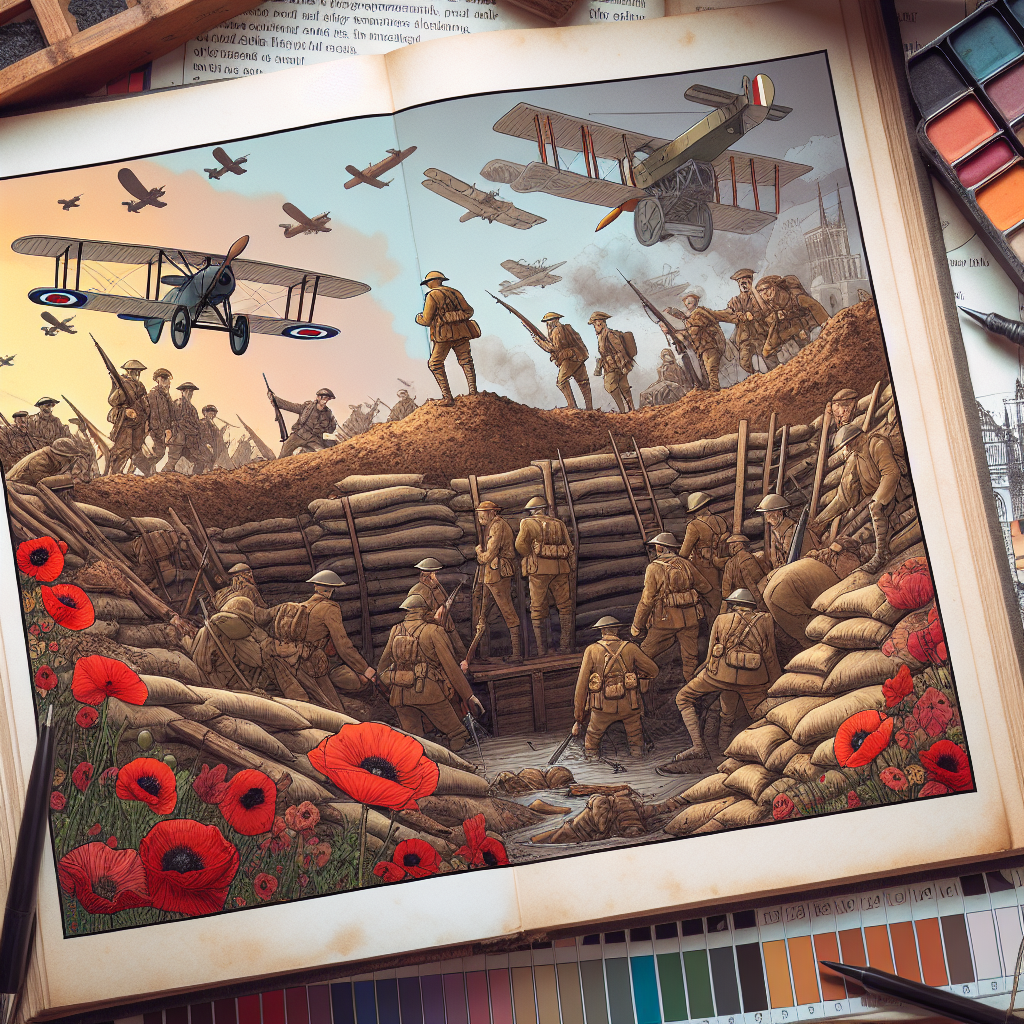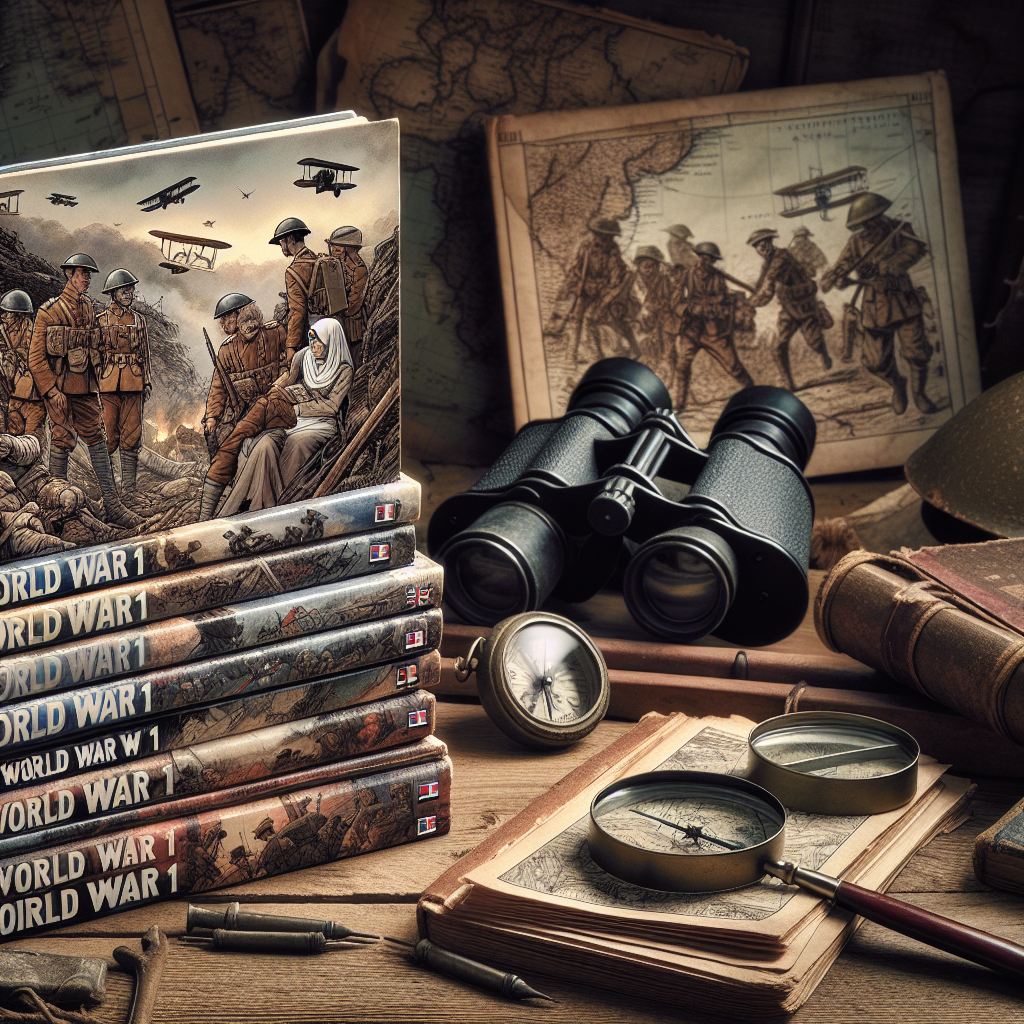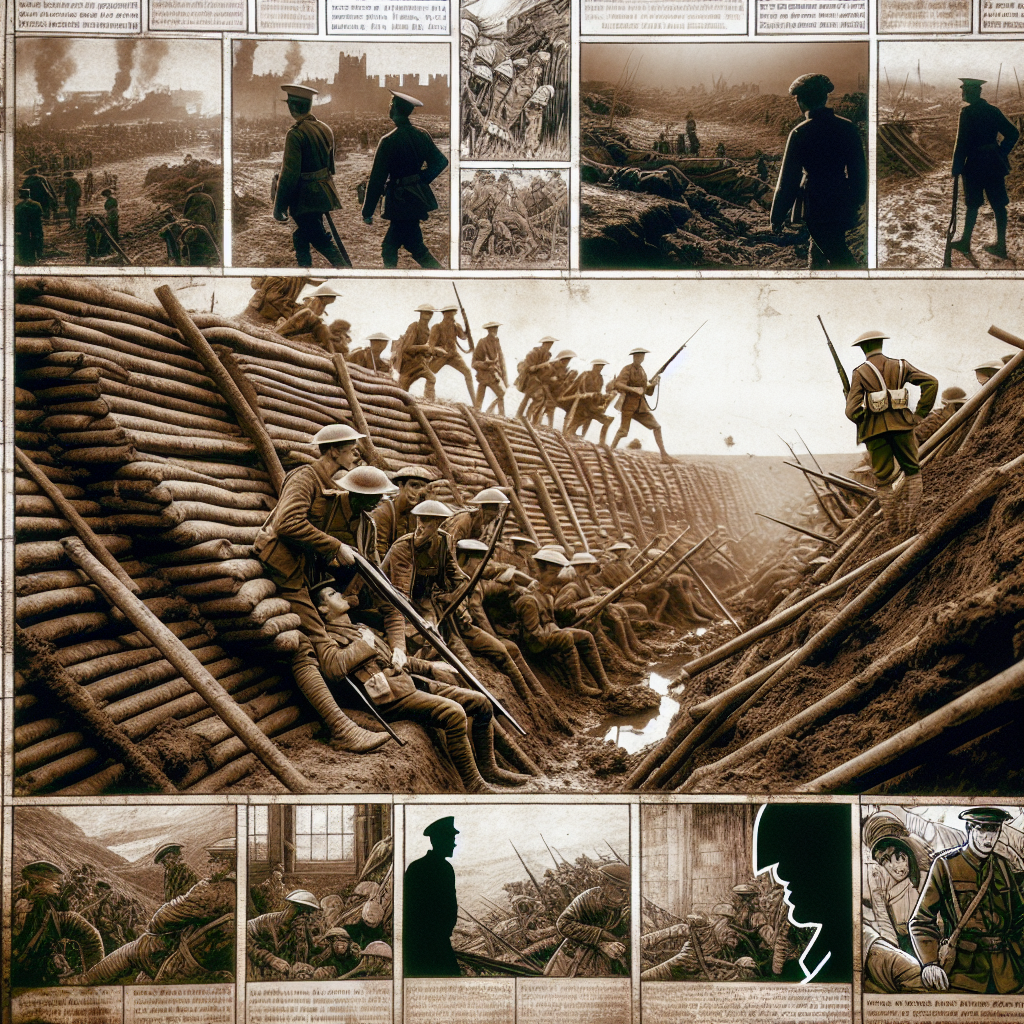Immerse yourself in the harrowing and poignant world of World War 1 through the captivating lens of graphic novels. This comprehensive analysis delves into the impact and representation of the Great War through the powerful visual storytelling of artists and authors. From the trenches to the home front, these graphic novels provide a unique and evocative perspective on the experiences of soldiers, civilians, and the lasting effects of this catastrophic conflict. Join us on a journey through history as we explore the artistry and storytelling of these graphic novels that bring the complexities of World War 1 to life in a vivid and compelling way.
Understanding World War 1: An Overview

Brief History of World War 1
World War 1, also known as the Great War, was a global conflict that lasted from 1914 to 1918. It originated in Europe but quickly spread to involve many countries from various continents. The war was primarily fought between the Allied Powers, including France, Russia, and the United Kingdom, against the Central Powers, which consisted of Germany, Austria-Hungary, and the Ottoman Empire. The assassination of Archduke Franz Ferdinand of Austria in 1914 served as a catalyst for the outbreak of the war. The conflict was characterized by trench warfare, technological advancements in weaponry, and a staggering loss of life.
Significance and Impact of World War 1 on Global History
World War 1 had a profound impact on global history, shaping the geopolitical landscape for years to come. The war marked the end of the old world order and the beginning of a new era defined by modern warfare and shifting alliances. The Treaty of Versailles, which officially ended the war, imposed heavy penalties on Germany and laid the groundwork for the rise of Adolf Hitler and the start of World War 2. Additionally, the war led to the dissolution of empires, the redrawing of borders, and significant social and cultural changes. The immense human cost of the war, with millions of soldiers and civilians losing their lives, left a lasting impact on societies around the world.
Evolution of Graphic Novels
Traditional Literature vs. Graphic Novels
Evolution of Graphic Novels
- Comparison of traditional literature and graphic novels
In comparing traditional literature with graphic novels, it is essential to note the distinct differences in their storytelling methods. Traditional literature relies heavily on prose, utilizing descriptive language to paint a vivid picture in the reader’s mind. On the other hand, graphic novels combine text with visual elements, such as illustrations and panels, to convey the narrative. This visual component adds another layer of depth to the storytelling, allowing for a more immersive experience for the reader.
- Rise in popularity and acceptance of graphic novels as a form of storytelling
Over the years, there has been a significant rise in the popularity and acceptance of graphic novels as a legitimate form of storytelling. Initially perceived as mere comic books, graphic novels have evolved into a sophisticated medium that tackles complex themes and narratives. Their inclusion of visual artistry alongside written narrative has attracted a diverse audience, including those who may not typically engage with traditional literature. This shift in perception has led to graphic novels being recognized as valuable tools for exploring historical events, such as World War 1, in a unique and impactful way.
Influence of Graphic Novels in Depicting Historical Events
Graphic novels have become a powerful medium for depicting historical events, providing a unique visual way to engage with and understand complex narratives. Through the integration of text and artwork, graphic novels offer a multi-dimensional approach to storytelling that can evoke emotional responses and immerse readers in the historical context.
Role of graphic novels in portraying historical events:
- Graphic novels have the ability to bring historical events to life through vivid illustrations and compelling storytelling techniques. By visually representing key moments in history, graphic novels make the past more accessible and engaging for readers of all ages.
- Unlike traditional historical texts, graphic novels often focus on the human experiences and personal stories behind major events, offering a more intimate and relatable perspective on history. This personalized approach allows readers to connect on a deeper level with the impact of historical events.
- Through the use of sequential art and panel layouts, graphic novels can effectively convey the passage of time, the complexity of historical conflicts, and the interconnectedness of various historical figures and events. This visual storytelling aspect enhances the reader’s understanding and emotional connection to the historical narrative.
Unique visual storytelling elements in graphic novels:
- Graphic novels employ a range of visual techniques such as panel composition, color symbolism, and character design to convey historical themes and evoke specific moods or emotions. The visual elements in graphic novels play a crucial role in immersing readers in the historical setting and creating a sense of authenticity.
- The combination of text and images in graphic novels allows for a dynamic interplay between words and visuals, enabling creators to communicate complex historical information in a concise and engaging manner. This integration of text and art enhances the overall narrative impact and facilitates a deeper understanding of historical events.
- Graphic novels also have the flexibility to experiment with unconventional storytelling methods, such as nonlinear narratives, dream sequences, and metaphorical imagery, to explore the deeper implications of historical events and challenge traditional interpretations. This artistic freedom enables graphic novelists to push the boundaries of historical representation and offer fresh perspectives on familiar historical subjects.

Representation of World War 1 in Graphic Novels
Themes and Motifs
- Exploration of common themes in graphic novels about World War 1
Graphic novels centered around World War 1 often explore themes such as the horrors of trench warfare, the impact of technology on combat, the psychological toll on soldiers, and the disillusionment of war. These themes are depicted through the experiences of characters who grapple with loss, trauma, patriotism, and the futility of conflict. The graphic medium allows for a visceral portrayal of the brutality of war, capturing both the physical and emotional devastation faced by individuals caught up in the conflict.
- Analysis of motifs used to depict the era accurately
To accurately represent the era of World War 1, graphic novels frequently incorporate motifs such as trench warfare landscapes, gas masks, barbed wire, military uniforms, propaganda posters, and symbolic imagery like poppies and red fields. These motifs serve to contextualize the narrative within the historical period, conveying the gritty reality of life on the front lines and the broader societal impact of the war. Through meticulous attention to detail in depicting weaponry, uniforms, architecture, and cultural references of the time, graphic novelists aim to immerse readers in the authentic atmosphere of World War 1, fostering a deeper understanding of the historical context and its lasting repercussions.
Character Development and Storytelling
- Character arcs in graphic novels set during World War 1: One of the key aspects of exploring the impact of World War 1 through graphic novels is the in-depth portrayal of character development. Graphic novels often delve into the personal journeys of individuals caught in the turmoil of war, showcasing their struggles, growth, and transformation amidst the chaos of battlefields. Characters are portrayed with depth and complexity, reflecting the psychological and emotional toll of the war on individuals from various backgrounds.
- Narrative techniques used to convey the wartime experience: Graphic novels employ a variety of storytelling techniques to vividly capture the essence of World War 1. Through the use of visual elements such as panel layouts, colors, and artistic styles, graphic novelists convey the intensity and brutality of war, as well as the intimate moments of camaraderie and loss experienced by characters. Additionally, the incorporation of dialogue, inner monologues, and flashbacks helps to provide a multi-dimensional view of the characters’ experiences, allowing readers to empathize with their struggles and triumphs.
Notable Graphic Novels about World War 1
“The Great War: July 1, 1916: The First Day of the Battle of the Somme” by Joe Sacco
Notable Graphic Novels about World War 1
- Overview of the Graphic Novel
“The Great War: July 1, 1916: The First Day of the Battle of the Somme” by Joe Sacco is a meticulously crafted graphic novel that delves into the harrowing events of the Battle of the Somme during World War 1. Sacco’s unique storytelling through illustrations captures the brutal reality of war, depicting the chaos and devastation experienced by soldiers on both sides of the conflict. The novel follows the soldiers as they navigate the trenches, highlighting the human cost of warfare and the psychological toll it takes on individuals.
- Analysis of the Historical Accuracy and Impact
Sacco’s graphic novel is renowned for its historical accuracy, as he extensively researched the events of the Battle of the Somme to ensure authenticity in his depiction. The detailed illustrations offer readers a glimpse into the conditions faced by soldiers during this significant battle, shedding light on the challenges and horrors of war. The impact of the novel lies in its ability to humanize the experiences of those who lived through the conflict, allowing readers to empathize with the individuals caught in the midst of battle. Sacco’s work serves as a poignant reminder of the sacrifices made during World War 1 and the enduring legacy of the Great War on society.
“Charley’s War” by Pat Mills and Joe Colquhoun
“Charley’s War” is a renowned graphic novel that delves deep into the harrowing realities of World War 1 through the eyes of its protagonist, Charley Bourne. The story follows Charley, a teenage soldier who lies about his age to enlist in the British Army and finds himself thrust into the brutal trenches of the Western Front.
Synopsis of the graphic novel:
The narrative of “Charley’s War” unfolds with gripping intensity, portraying the horrors of war with unflinching realism. Charley navigates through the grim landscape of battlefields, gas attacks, and the camaraderie among soldiers, offering a poignant portrayal of the human cost of conflict.
Discussion on the depiction of the soldier’s perspective in World War 1:
Mills and Colquhoun skillfully capture the soldier’s perspective in World War 1 by immersing the readers in Charley’s experiences and emotions. Through vivid illustrations and poignant dialogue, the graphic novel conveys the fear, camaraderie, and trauma faced by soldiers on the front lines. The depiction of the soldier’s perspective in “Charley’s War” serves as a powerful testament to the resilience and sacrifices of those who served during the Great War.
“It Was the War of the Trenches” by Jacques Tardi
- Summary of the graphic novel:
- “It Was the War of the Trenches” by Jacques Tardi delves into the brutal realities of World War 1, focusing on the experiences of soldiers in the trenches. Through a series of vignettes, the graphic novel portrays the horror, despair, and futility of war, highlighting the psychological toll it takes on individuals caught in its grasp. Tardi’s narrative is raw and unflinching, offering a stark portrayal of the harsh conditions faced by soldiers during this tumultuous period in history.
- Examination of the visual style and storytelling approach:
- Tardi’s visual style in “It Was the War of the Trenches” is characterized by its gritty realism and attention to detail. The illustrations are stark and haunting, capturing the grim atmosphere of the battlefield with precision. Through his use of dark, moody colors and intricate linework, Tardi effectively conveys the sense of claustrophobia and chaos that defined trench warfare.

- In terms of storytelling approach, Tardi employs a nonlinear narrative structure, jumping between different perspectives and timelines to offer a multifaceted view of the war. This technique allows readers to witness the war from various angles, providing a more comprehensive understanding of its impact on individuals and societies. Through poignant dialogue and poignant imagery, Tardi brings to life the untold stories of those who lived and died in the trenches, shedding light on the human cost of conflict.
Impact of Graphic Novels on Understanding World War 1
Educational Value
- Graphic novels serve as effective educational tools for learning about the complexities of World War 1. They provide a unique visual representation that can help readers, especially students, grasp historical events and contexts more easily. By combining text with illustrations, graphic novels offer a multi-sensory experience that enhances comprehension and retention of information.
- The visual storytelling in graphic novels engages readers on a different level. The use of images, dialogue bubbles, and panel layouts conveys emotions, actions, and historical settings in a vivid and impactful way. This visual engagement can stimulate interest in learning about World War 1, making the subject matter more accessible and relatable to a wider audience.
- Through graphic novels, complex historical narratives can be simplified and made more digestible. The combination of visuals and text allows for the portrayal of intricate events, political dynamics, and personal experiences in a coherent and compelling manner. This not only increases understanding but also encourages critical thinking and analysis of the historical context surrounding World War 1.
Preservation of Memory
Impact of Graphic Novels on Understanding World War 1
The role of graphic novels in preserving the memory of World War 1 is profound and multifaceted. Through vivid illustrations and compelling narratives, graphic novels have the power to capture the emotional essence of historical events in a visually engaging manner, resonating with readers on a deep level. By depicting the experiences of soldiers, civilians, and other individuals impacted by the war, graphic novels provide a personalized and intimate perspective that goes beyond traditional historical accounts.
Contribution to keeping the historical narrative alive for future generations is a key aspect of the preservation of memory through graphic novels. These visual narratives serve as a bridge between the past and the present, offering a unique lens through which to view and interpret the events of World War 1. By presenting historical facts in a visually stimulating format, graphic novels appeal to a wider audience, including younger generations who may be less inclined to engage with traditional historical texts.
Furthermore, the emotive power of graphic storytelling enables readers to empathize with the struggles and triumphs of individuals during the war, fostering a deeper connection to the past. Through the combination of visuals and text, graphic novels create a sensory experience that immerses readers in the historical context, making the events of World War 1 more tangible and relatable. This immersive quality helps to ensure that the memory of the war remains vibrant and relevant, continuing to resonate with audiences long after the conflict has ended.
FAQs: Graphic Novels about World War 1
Can you recommend some graphic novels about World War 1?
There are several graphic novels that explore the impact and representation of World War 1. Some popular titles include “The Great War: July 1, 1916: The First Day of the Battle of the Somme” by Joe Sacco, “Charley’s War” by Pat Mills and Joe Colquhoun, “War Stories” by Garth Ennis, and “The Harlem Hellfighters” by Max Brooks.
How do graphic novels contribute to our understanding of World War 1?
Graphic novels offer a unique and visually compelling way to explore the complexities and human stories of World War 1. The combination of text and illustrations can provide a deeper emotional connection to the historical events and characters, offering readers a more immersive experience.
Are graphic novels about World War 1 historically accurate?
While some graphic novels may take creative liberties with certain aspects of the historical events, many authors and artists strive to accurately depict the timeline, events, and environments of World War 1. It is important for readers to critically engage with the source material and seek out additional context to supplement their understanding of the war.
How can graphic novels be used in educational settings to teach about World War 1?
Graphic novels can be a valuable tool in educating students about World War 1. Teachers can incorporate graphic novels into history lessons to provide a more engaging and accessible way for students to learn about the war. Visual storytelling can help students connect emotionally with the events and characters, fostering a deeper understanding of the impact of World War 1.
0 Comments